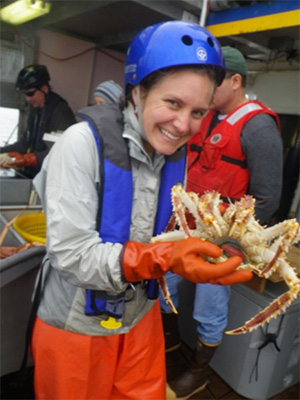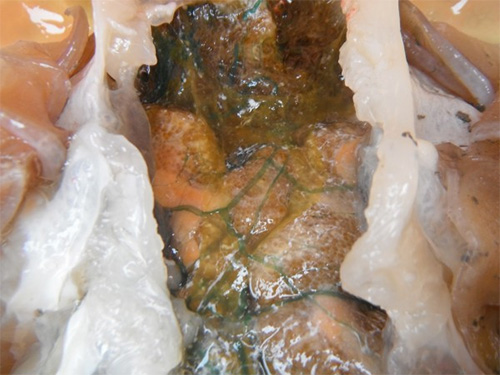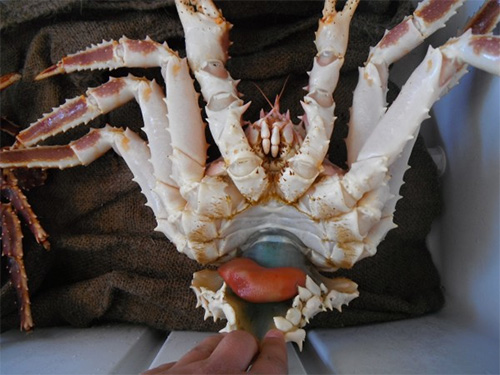
Zombie-generating crab parasites pose intriguing mysteriesBy LAUREN FRISCH
March 30, 2016
King crabs, already otherworldly-looking creatures, grow even stranger when barnacles invade them. The insides of infected crabs become filled with green, branching tendrils that resemble plant roots more than anything.
Barnacles are marine animals with outer shells, related to crabs and lobsters. Typically, they live on rocks or the sides of boats, filtering food out of the water. However, Briarosaccus barnacles infect king crabs, turning them into “zombie” crabs that raise and nurture the parasite’s eggs. The mechanisms behind this control are unknown. Additionally, scientists do not have a strong understanding of how many crabs are infected or under what conditions the parasite thrives. Leah Sloan, a PhD student at the University of Alaska Fairbanks School of Fisheries and Ocean Sciences, is studying both the mechanism for control and the range of temperatures and salinities the barnacle can tolerate. Working with SFOS associate professor of marine biology Sarah Hardy, Sloan wants to raise awareness about the barnacle and develop easier ways to detect infected crabs. Most of the southern and western coasts of Alaska support commercial fisheries for king crabs, which are distributed to human consumers worldwide. In 2014, the total ex-vessel value for blue, red, and golden king crab fisheries amounted to approximately $96 million. “I was excited to take on this research because of its potential importance to the valuable king crab fisheries of Alaska, but also wanted to study this species simply because of the thrill of discovering the secrets of a species that hardly anyone has ever studied before,” Sloan said. In the ocean environment, the larvae of the parasitic barnacle settle on a crab and inject cells into the crab’s bloodstream. These cells divide and spread through the body of the crab. These are not your typical beach barnacles. While barnacles are usually encrusters, meaning they attach themselves to another surface, the body of the Briarosaccus regalis is a bright green branching and root-like structure, which forms inside infected crabs. Different species of Briarosaccus barnacles infect the three commercially-harvested king crabs in Alaska. Sloan is focused on Briarosaccus regalis, which infects red and blue king crabs.
The green, stringy Briarosaccus regalis spread all over the insides of this red king crab. The yellow, brown and white parts are normal crab internal organs.
Don’t worry, Sloan assures, the parasites won’t turn us into zombies if we eat them by accident. For the most part, the parasite will stay in the body cavity of the crab, while people eat only crab legs. And even if we were to eat the parasite, we would digest it normally. The crabs, however, are prevented from reproducing by their barnacle parasites. In addition, the roots that grow inside the crabs develop barnacle reproductive organs in the form of an egg sac in the abdominal flap of the crab, where a female crab would keep its own eggs. “Both male and female crabs will become very good mothers for that egg sac,” Sloan said. “They will clean the parasite’s egg sac. They will flap their abdomen to help bring in oxygenated water. They will put their abdomen up in the water column to release the parasite larvae so they can get dispersed better.” Researchers hypothesize that the control is hormonally driven. If the barnacle injects female hormones into the crabs they infect, this could explain why both male and female crabs become dedicated, nurturing mothers to their parasite egg sac. Sloan first became aware of the parasitic barnacle as an undergraduate researcher at California State University, Long Beach. She was studying a similar parasite that infects porcelain crabs. When she was accepted at UAF, Sloan wanted to continue studying parasitic barnacles. “Given the importance of king crabs to the ecosystem and as a fishery resource, studying the barnacle that infects them seemed like an obvious choice,” Sloan said.
The red pouch is a visible parasite egg sac on an infected male red king crab. The blue-green parasite is visible behind the pouch in the innards of the crab.
In the lab, Sloan raised parasite larvae at different temperatures and levels of salinity to monitor survival frequency and length of development. Her project is part of the National Science Foundation–funded Marine Ecosystem Sustainability in the Arctic and Subarctic program. She received additional funding from a North Pacific Research Board student grant, a Rasmuson fellowship, the Northern Gulf of Alaska Applied Research Award, and the SFOS Robert and Kathleen Byrd award. Sloan found that parasite larvae can survive at a range of temperatures and salinities, and concludes changes in the ocean are probably not going to have a substantial direct impact on parasite larvae survival. However, changes in temperature can impact development time, which may indirectly impact parasite survival. At the coldest temperature treatment of 2 degrees Celsius, a normal modern temperature for Bering Sea water, development time for larvae was 43 days on average. In the warmest temperature treatment at 16 C, larvae developed in 11 days on average. “The barnacle larvae have to survive in the water column a lot longer when water temperatures are colder,” Sloan said. “There is a lot greater probability that they will get eaten or drift to an unfavorable habitat off the shelf. In general, they face a lot of dangers in the larval stages that might have a larger effect when development takes longer.” When development time is shorter, it could be easier for larvae to survive that initial vulnerability. “As ocean water gets warmer, the larvae will develop faster. But we still don’t really know for sure how that will play out, or what it means for the survival of the larvae,” Sloan said. Unless a parasite’s egg sac is present, biologists cannot determine visually whether crabs are infected. Sloan is studying small molecules, including hormones, in infected and noninfected crabs. She hopes to develop biomarkers that would allow scientists to identify infected crabs with a blood test. “She’s doing a shotgun approach,” Hardy said. “By looking at all of the biochemical compounds that are present in both infected crabs and noninfected crabs, she is hoping to determine which compounds are in the infected crabs that may be responsible for the control.” To date, not much has been done by way of management, both because the barnacle is native to Alaska waters and because it hasn’t been a huge problem for commercial fisheries yet. But one concern is that commercial fishing may be inadvertently helping barnacle numbers increase. The barnacle can slow down growth of king crabs, resulting in infected crabs that are below the legal size for fishermen. Many of these small, infected crabs get thrown back. In Southeast Alaska, golden king crab commercial fisheries allow fishermen to keep any infected crabs, even if they are under the size limit or if they are female. This is one way to encourage the fishermen to limit the spread of the parasite, although crabs without a parasite’s egg sac may still get thrown back undetected. If Sloan develops a method that makes it easier to identify infected crabs, this could help the researchers determine how many infected crabs are in Alaska waters and work on strategies to mitigate the impact of the parasite on commercial crab populations.
This article is provided as a public service by the University of Alaska Fairbanks' School of Fisheries and Ocean Sceinces.
Representations of fact and opinions in comments posted below are solely those of the individual posters and do not represent the opinions of Sitnews.
|
|||


